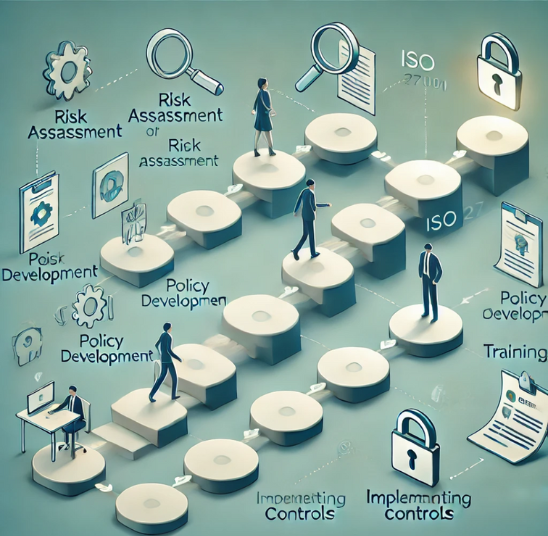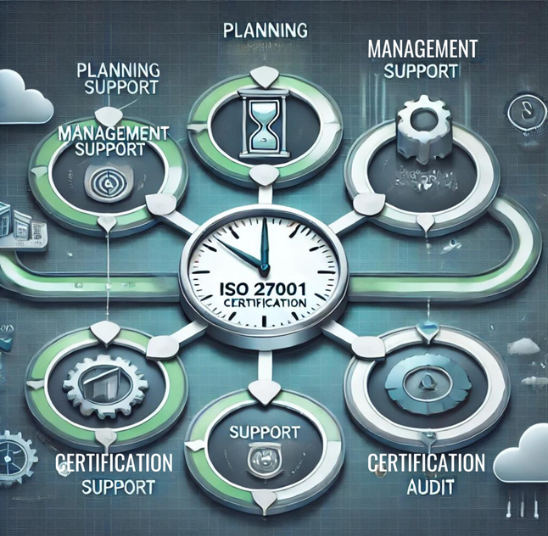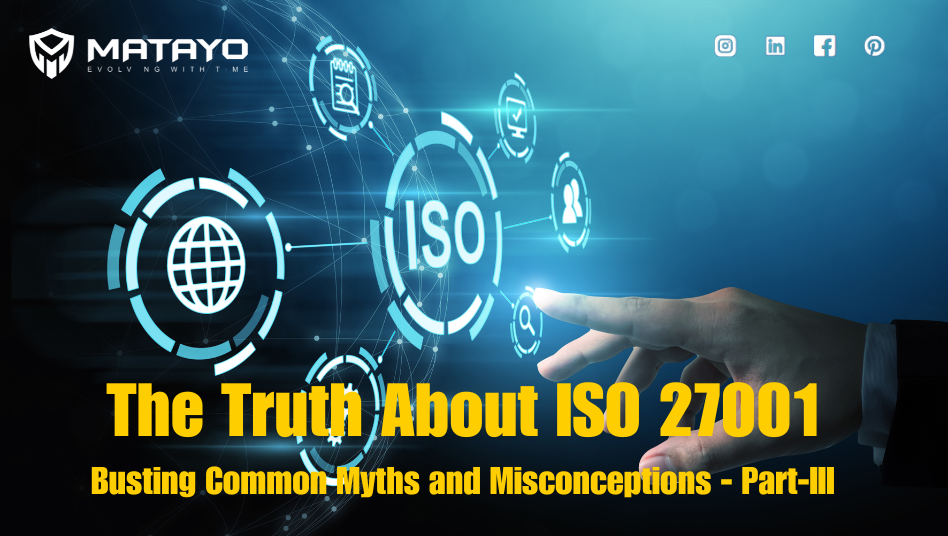Myth 7: ISO 27001 is Too Complex to Implement
One of the most common myths about ISO 27001 is that it is too complex and overwhelming to implement. Many organizations, especially smaller ones, may feel intimidated by the perceived complexity of the standard and the extensive documentation it requires. However, this belief can deter businesses from pursuing certification, missing out on the numerous benefits that ISO 27001 offers.
I. Reality: ISO 27001 Implementation is Manageable with the Right Approach
While the ISO 27001 standard is comprehensive, it is designed to be flexible and adaptable. Implementation does not have to be an all-at-once process. By breaking it down into manageable steps and focusing on high-priority areas first, organizations can implement ISO 27001 in a way that suits their specific needs and resources.
Key Strategies for Simplifying Implementation:
Step-by-Step Approach: Organizations can tackle ISO 27001 one phase at a time. For instance, start by conducting a risk assessment to identify the most critical areas that need attention, then gradually implement controls and policies in those areas.
Tailoring to Specific Needs: ISO 27001 is not a one-size-fits-all standard. Businesses can tailor the implementation to their specific industry, size, and risk profile, focusing on areas most relevant to their operations.
Utilizing External Expertise: If internal resources are limited, organizations can seek guidance from consultants or use specialized tools designed to simplify the implementation process. External experts can provide valuable insights and help navigate the complexities.
II. Real-Time Example: Simplified ISO 27001 Implementation in a Small Business
Consider a small IT services company that decided to pursue ISO 27001 certification to strengthen its security posture and attract larger clients. Initially, the team was overwhelmed by the standard’s requirements and the volume of documentation needed.
To make the process more manageable, the company decided to implement ISO 27001 in phases:
Phase 1:
Risk Assessment – The company began by conducting a thorough risk assessment to identify its most critical assets and vulnerabilities. This step helped them prioritize which areas to focus on first.
Phase 2:
Policy Development – Next, they developed a set of security policies tailored to their specific needs, such as data protection, access control, and incident response. They used templates and guidance from ISO 27001 experts to streamline this process.
Phase 3:
Training and Awareness – The company then conducted training sessions for all employees to ensure they understood the new policies and their role in maintaining information security.
Phase 4:
Implementation of Controls – Finally, they implemented the necessary technical controls, such as encryption and access controls, and set up regular monitoring and auditing processes.
By breaking down the implementation into these manageable steps, the company successfully achieved ISO 27001 certification within a year. Not only did they enhance their security practices, but they also gained new clients who required ISO 27001-certified partners, proving that even a small business can navigate the complexities of ISO 27001 with the right approach.

Conclusion:
ISO 27001 implementation may seem complex at first glance, but it is entirely achievable with a structured, phased approach. By breaking the process down into manageable steps and focusing on specific needs, organizations of any size can successfully implement ISO 27001, enhancing their security posture and unlocking new business opportunities.

Myth 8: ISO 27001 is Just About Documentation
A common misconception about ISO 27001 is that it’s primarily about generating piles of documentation. Many organizations believe that compliance revolves around creating and maintaining extensive paperwork, which can lead to the misunderstanding that the standard is more about formality than actual security. However, this myth oversimplifies what ISO 27001 is truly about.
I. Reality: ISO 27001 Goes Beyond Documentation
While documentation is a critical component of ISO 27001, it’s only part of the broader picture. The standard is fundamentally about establishing a robust Information Security Management System (ISMS) that fosters a culture of security within the organization. It’s about embedding security into the very fabric of the company, ensuring that everyone—from the top management to frontline employees—is aware of and committed to protecting information assets.
Key Elements Beyond Documentation:
Security Culture: ISO 27001 emphasizes creating a security-conscious environment where employees understand the importance of information security and are actively involved in maintaining it.
Training and Awareness: Continuous training programs are crucial. Employees need to be regularly educated about the latest security threats, best practices, and their specific roles in safeguarding information.
Risk Assessments: Regular risk assessments are a core part of ISO 27001. These assessments help identify vulnerabilities, evaluate potential threats, and prioritize actions to mitigate risks.
Implementation of Controls: ISO 27001 requires the implementation of various technical, physical, and procedural controls to protect information. This includes everything from encryption and access control to physical security measures and incident response planning.

II. Real-Time Example: Building a Security Culture with ISO 27001
Consider a medium-sized healthcare organization that handles sensitive patient information. Initially, the organization viewed ISO 27001 as just another compliance requirement, focusing heavily on documentation. They completed the necessary paperwork but soon realized that merely having documentation in place wasn’t enough to protect their information assets effectively.
Recognizing the need for a more comprehensive approach, the organization shifted its focus to building a strong security culture. They took the following steps:
Management Commitment: Top management led by example, openly discussing the importance of information security in meetings and communications. This helped set the tone for the entire organization.
Employee Training: The organization launched a series of mandatory training sessions for all employees. These sessions covered topics like recognizing phishing emails, using secure passwords, and understanding the consequences of data breaches.
Regular Risk Assessments: The company conducted regular risk assessments to identify potential threats, such as vulnerabilities in their IT systems or risks related to third-party vendors. These assessments guided them in implementing targeted security controls.
Practical Controls Implementation: They implemented technical controls such as multi-factor authentication and encryption for sensitive data. Additionally, they established clear protocols for incident response, ensuring that everyone knew how to respond in case of a security breach.
Continuous Improvement: The organization made it a point to continuously review and improve its ISMS, ensuring that its security practices evolved with emerging threats and technological advancements.
By focusing on these aspects, the organization successfully moved beyond a documentation-centric approach to ISO 27001. They cultivated a proactive security culture that not only protected patient information but also enhanced their reputation and trust among clients.
Conclusion:
ISO 27001 is far more than just documentation. It’s about creating a comprehensive and dynamic information security framework that involves every part of the organization. By fostering a culture of security awareness, conducting regular risk assessments, and implementing effective controls, organizations can truly realize the benefits of ISO 27001 and protect their information assets against evolving threats.

Myth 9: ISO 27001 Certification Takes Too Long
A common myth about ISO 27001 certification is that it takes an excessively long time to achieve, leading many organizations to hesitate before starting the process. The perception that certification is a drawn-out, cumbersome process can discourage businesses, especially small and medium-sized enterprises (SMEs), from pursuing it. However, this myth doesn’t reflect the reality of how ISO 27001 certification can be managed.
I. Reality: ISO 27001 Certification Can Be Achieved in a Reasonable Timeframe
The timeline for achieving ISO 27001 certification varies depending on several factors, including the size of the organization, the complexity of its operations, and the resources dedicated to the project. However, with proper planning, a clear roadmap, and commitment from the organization, certification can be obtained within a reasonable timeframe—sometimes even within a few months.
Key Factors for Achieving Timely Certification:
Detailed Planning: A well-thought-out project plan is essential. By setting clear goals, timelines, and responsibilities, the organization can stay on track and avoid unnecessary delays.
Management Support: Strong leadership and commitment from top management are crucial for driving the project forward and ensuring that resources are allocated efficiently.
Prioritization of Key Areas: Focusing on high-priority areas, such as risk assessment and control implementation, can accelerate the certification process without compromising the quality of the ISMS.
External Expertise: Engaging with ISO 27001 consultants or using specialized tools can provide valuable guidance, helping to streamline the process and avoid common pitfalls.

II. Real-Time Example: Fast-Tracking ISO 27001 Certification in a Growing Tech Startup
Consider a growing tech startup that handles sensitive customer data and recognizes the need for ISO 27001 certification to build trust and secure larger contracts. The startup is concerned about the time commitment but understands the importance of certification for its long-term success.
Here’s how they approached the certification process:
Initial Assessment and Planning: The startup began by conducting an initial gap analysis to understand where they stood in terms of compliance. They then created a detailed project plan, breaking down the certification process into manageable phases with specific timelines.
Management Buy-In: The CEO and top management were fully committed to the project, regularly communicating its importance to the entire team. They ensured that necessary resources, including time and budget, were allocated to meet the deadlines.
Focused Implementation: The startup prioritized the most critical areas first, such as securing customer data and implementing key controls like encryption and access management. They used templates and best practices to speed up the development of necessary documentation.
Engaging External Experts: To further accelerate the process, the startup hired an ISO 27001 consultant who provided expertise and helped navigate the more complex aspects of the standard. The consultant also helped conduct internal audits to ensure everything was on track.
Certification Audit: Within six months, the startup was ready for the certification audit. Thanks to their focused approach and the guidance of their consultant, they passed the audit with minimal issues and obtained their ISO 27001 certification.
By effectively planning and prioritizing, the startup was able to achieve ISO 27001 certification in a relatively short period. This accomplishment not only enhanced their security posture but also opened doors to new business opportunities that required ISO 27001-certified partners.
Conclusion:
ISO 27001 certification doesn’t have to be a lengthy, drawn-out process. With proper planning, management support, and the right resources, organizations can achieve certification within a reasonable timeframe. The benefits of ISO 27001 far outweigh the effort required, and a well-executed certification process can be a game-changer for businesses looking to enhance their credibility and competitiveness.

Myth 10: ISO 27001 Doesn’t Improve Business Processes
One common myth surrounding ISO 27001 is that it’s purely a security standard and doesn’t contribute to improving overall business processes. Some organizations may view the certification as an isolated effort focused solely on compliance without realizing the broader benefits it can bring to their operations. However, this perception overlooks the transformative impact that ISO 27001 can have on an organization’s efficiency, resilience, and overall business performance.
I. Reality: ISO 27001 Enhances Business Processes
Implementing ISO 27001 goes beyond just meeting compliance requirements; it fundamentally improves how an organization operates. By introducing a structured approach to information security management, ISO 27001 helps organizations streamline their processes, identify and eliminate inefficiencies, and establish robust risk management practices. These improvements often lead to increased efficiency, resilience, and customer confidence.
Key Benefits of ISO 27001 on Business Processes:
Increased Customer Confidence: By achieving ISO 27001 certification, organizations demonstrate their commitment to information security, which can significantly boost customer trust and confidence.
Streamlined Operations: ISO 27001 encourages the adoption of standardized processes, which reduces duplication of effort, minimizes errors, and enhances operational efficiency.
Risk Management: The standard requires organizations to regularly assess risks and implement controls to mitigate them, leading to better decision-making and reduced exposure to potential threats.
Continuous Improvement: ISO 27001 fosters a culture of continuous improvement, where organizations regularly review and update their processes to adapt to changing risks and business environments.

II. Real-Time Example: Transforming Business Processes with ISO 27001
Consider a mid-sized manufacturing company that handles a large amount of proprietary information, including trade secrets and customer data. Initially, the company pursued ISO 27001 certification to enhance its information security and meet customer demands. However, as they progressed through the implementation process, they discovered that ISO 27001 offered much more than just security benefits.
Here’s how ISO 27001 transformed their business processes:
- Process Standardization: During the initial assessment, the company identified several areas where operations were inconsistent, leading to inefficiencies and errors. By implementing ISO 27001, they standardized key processes across departments, resulting in more predictable and efficient operations.
- Improved Risk Management: The risk assessment process required by ISO 27001 helped the company identify not only security risks but also operational risks that had previously gone unnoticed. By addressing these risks, the company improved its overall business resilience, reducing the likelihood of disruptions.
- Elimination of Redundancies: The company found that certain tasks were being duplicated across different departments. ISO 27001’s focus on efficiency led them to streamline these tasks, eliminating redundancies and freeing up resources for more critical activities.
- Enhanced Documentation and Communication: As part of the certification process, the company improved its documentation and communication practices. This led to better coordination between departments, faster decision-making, and clearer accountability for various tasks.
- Increased Customer Trust: Upon achieving ISO 27001 certification, the company noticed a significant increase in customer confidence. Clients appreciated the company’s commitment to protecting their information, leading to stronger business relationships and more growth opportunities.
Through the implementation of ISO 27001, the company not only enhanced its information security but also experienced a noticeable improvement in its business processes. The streamlined operations, better risk management, and increased customer trust contributed to the company’s overall growth and success.
Conclusion:
ISO 27001 is not just about securing information—it’s a powerful tool for improving business processes. By embracing the standard, organizations can achieve greater efficiency, better risk management, and enhanced customer confidence, all of which contribute to long-term success.


